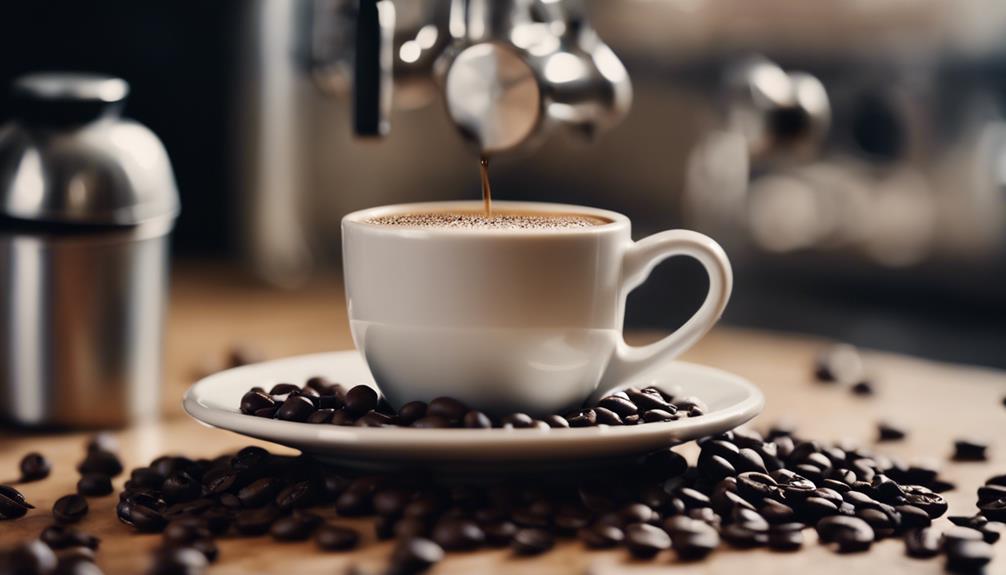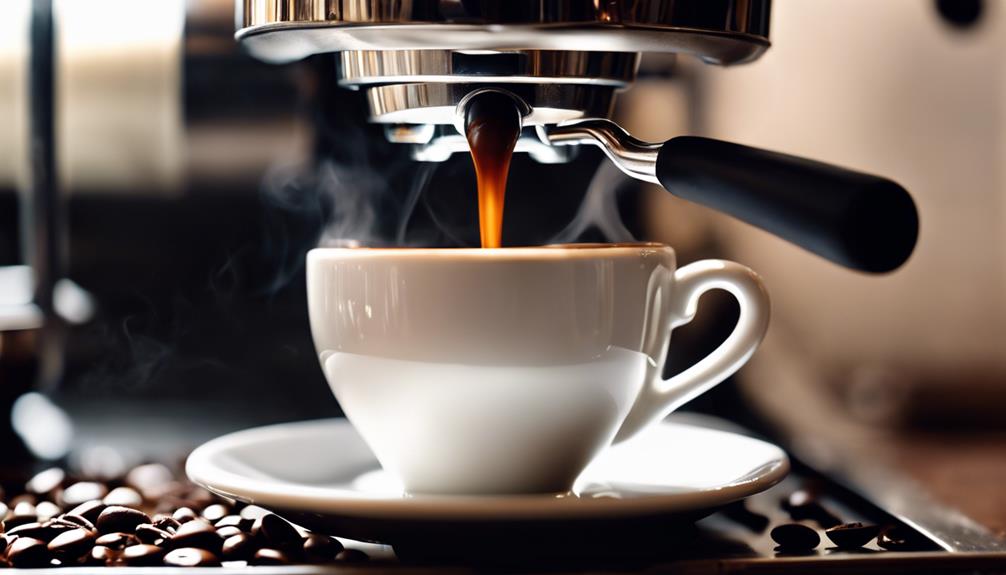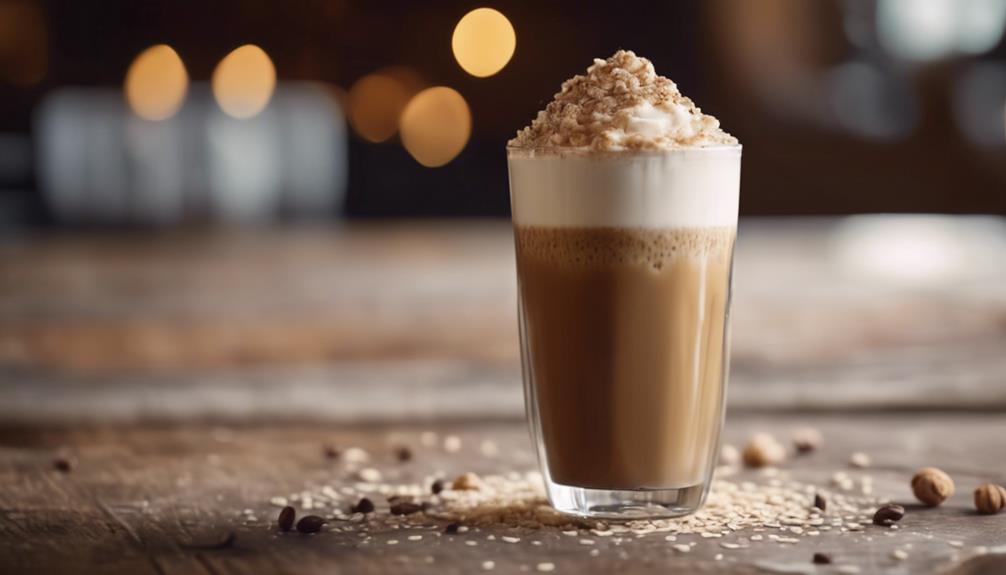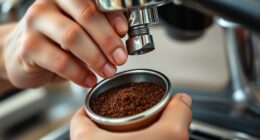To savor the smooth flavor of decaf blonde espresso, look for specialty roasters and online retailers. These outlets provide tasty choices that suit your tastes. Discover decaf blonde espresso for a rich coffee experience without caffeine. When you buy from specialty roasters, you can try various decaffeination techniques to elevate the flavor profiles. Don’t overlook the relaxing yet fulfilling sensation of decaf blonde espresso by exploring these avenues. You can discover a delightful cup of decaf blonde espresso that matches your flavor preferences.
Key Takeaways
- Look for specialty coffee shops offering decaf blonde espresso.
- Check online retailers for decaf blonde espresso options.
- Inquire at local cafes about decaf blonde espresso availability.
- Explore subscription services for decaf blonde espresso deliveries.
- Consider specialty roasters known for quality decaf blonde espresso.
Understanding Decaf Coffee Characteristics
If you're curious about decaf coffee, understanding its characteristics can enhance your brewing experience.
Decaffeinated coffee undergoes a decaffeination process before roasting, which involves soaking green coffee in water or steaming it. This process increases the coffee's solubility. However, it can also make decaf beans more brittle, impacting the grind size and extraction process.
When brewing decaf, adjusting the brew ratio instead of grinding finer can help compensate for its brittleness while maintaining a balanced cup profile.
Additionally, using a puck screen when brewing decaf espresso can improve water distribution and extraction consistency. Despite potential visual differences like a pale crema, focusing on proper adjustments and treatment can result in a sweeter and more delicious cup of decaf espresso.
Understanding these characteristics of decaf coffee is essential for achieving a consistently flavorful brew.
Importance of Solubility and Brittleness
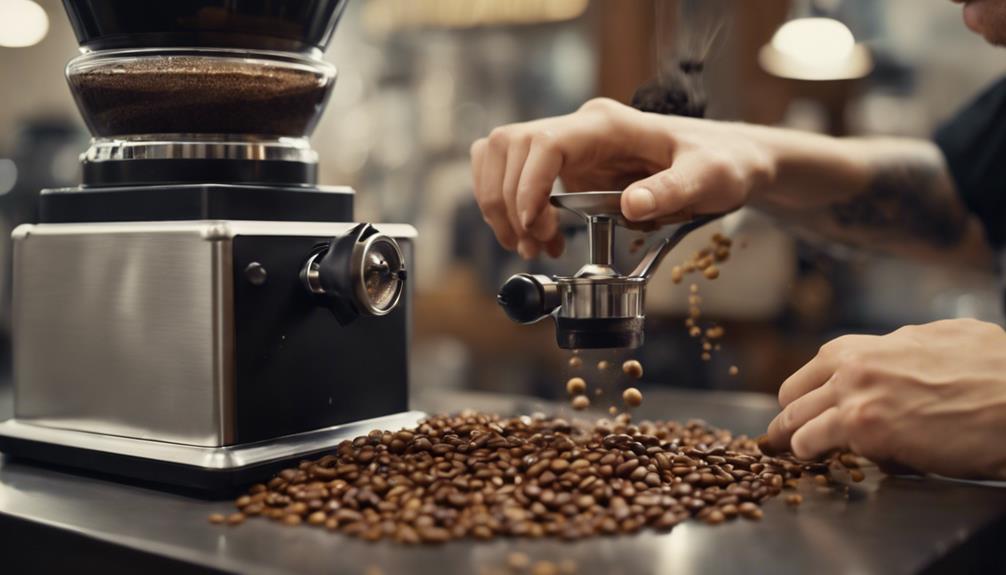
Decaf espresso's solubility is essential as it can easily lead to over-extraction when treated like regular espresso.
The brittleness of decaf beans impacts taste by producing more fines and reducing body in the shot.
Managing extraction time is key to achieving a balanced sweetness and acidity in your decaf espresso.
Solubility in Espresso
Improving solubility and managing brittleness are essential factors to take into account when brewing decaf blonde espresso. Considering the unique characteristics of decaf coffee, here are some key points to keep in mind:
- Decaf Solubility:
Decaf coffee exhibits increased solubility due to the decaffeination process. Be cautious not to over-extract, as it can happen more easily compared to regular espresso.
- Brittleness Impact:
Decaf beans tend to be brittle post-decaffeination, resulting in increased fines when ground finer. This can lead to a lack of body in the espresso.
- Compensating Measures:
To combat brittleness, utilize a puck screen for uniform water distribution. Consider slightly higher dosing to prevent the need for grinding finer.
- Brew Ratio Adjustment:
Instead of grinding finer, adjust the brew ratio by increasing it. Aim for a balanced cup with the right mix of sweetness and acidity.
Remember these tips to master the art of brewing decaf blonde espresso successfully.
Brittleness Impact on Taste
Managing the impact of brittleness on taste in decaf blonde espresso requires a nuanced approach that considers both solubility and grind consistency. Decaf coffee, due to its increased solubility from the decaffeination process, can easily become over-extracted if treated like regular espresso. To counter this, a lower brew time of around 20 seconds is recommended. However, the decaffeination process also renders decaf beans brittle, affecting their grind consistency and potentially causing under-extraction issues.
When addressing this brittleness, it's important to adjust the brew ratio by increasing it instead of grinding finer. This adjustment helps in balancing the sweetness and acidity in decaf espresso. For instance, using an 18g in, 41g out ratio in 23 seconds can achieve a harmonious flavor profile.
Grinding decaf coffee finer to compensate for brittleness may generate more fines, resulting in a lack of body in the espresso shot. Therefore, a higher dose is suggested to prevent grinding too fine and maintain the desired texture and taste.
Visual discrepancies like a pale and thin crema in decaf espresso can be remedied by focusing on proper treatment techniques that enhance taste despite the visual appearance.
Managing Extraction Time
To guarantee a well-balanced and flavorful decaf blonde espresso, attention to managing extraction time is essential, considering the impact of solubility and brittleness on the final taste profile. Here are four key tips to help you master the extraction process:
- Understand Solubility: Decaf coffee's increased solubility can lead to over-extraction if treated like regular espresso. Be mindful of this characteristic when adjusting your extraction time.
- Compensate for Brittleness: Avoid grinding decaf coffee too finely, as this can create more fines and result in a lack of body. Using a puck screen for even water distribution can help mitigate brittleness issues.
- Adjust Brew Ratio: Instead of grinding finer, consider increasing your brew ratio to achieve a balance of sweetness and acidity in your decaf blonde espresso. This adjustment can prevent under-extraction.
- Visual Differences: Decaf espresso may exhibit visual variances like a pale and thin crema. However, stirring the crema can enhance the taste, and focusing on proper extraction techniques will lead to a delicious cup despite these differences.
Adjusting Brewing Methods for Decaf
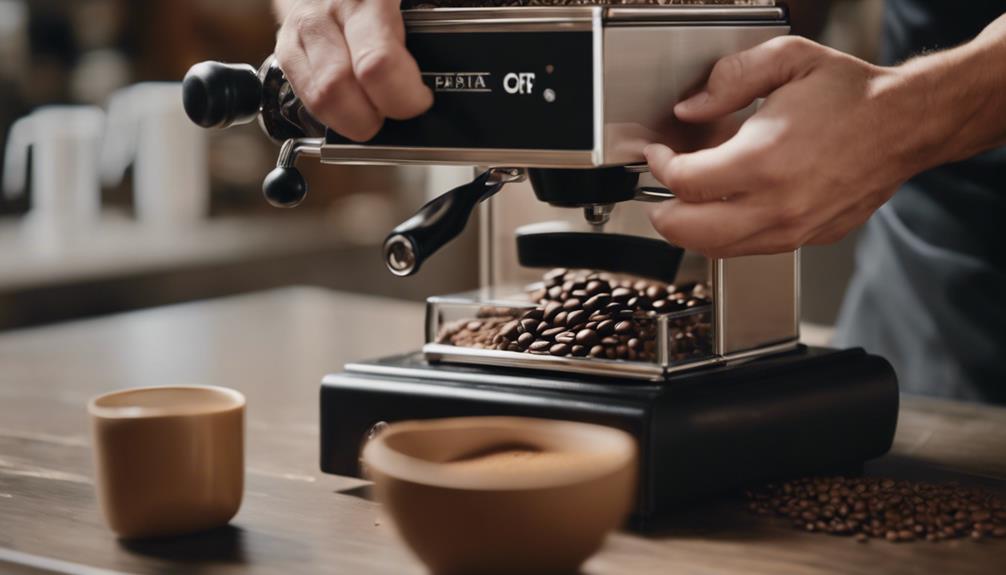
Consider adjusting your brewing methods when working with decaf coffee to account for its increased solubility and potential for over-extraction. Due to the decaffeination process before roasting, decaf coffee has heightened solubility, making it easier to extract more than desired if treated like regular espresso.
To prevent over-extraction, avoid grinding the coffee finer, use a puck screen for uniform water distribution, and dose slightly higher to avoid under-extraction. Instead of adjusting the grind size, focus on tweaking the brew ratio to achieve a balance of sweetness and acidity, resulting in a more delicious cup of decaf espresso.
Keep in mind that decaf espresso might exhibit a pale and thin crema, but stirring can enhance the taste and lead to a flavorful experience. By making these adjustments and maintaining the right approach, you can overcome visual differences and savor a delightful cup of decaf espresso by emphasizing proper treatment and brewing techniques.
Lower Brew Time Compensation
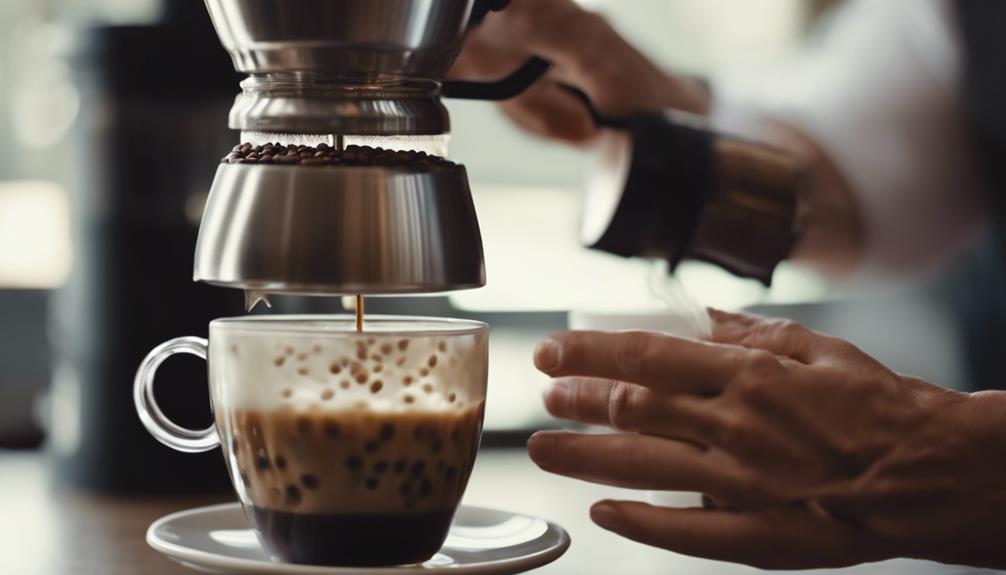
To address the challenge of lower brew time compensation when brewing decaf Blonde espresso, focus on adjusting your extraction techniques to achieve ideal flavor without over-extracting the coffee. Here are some tips to help you navigate this process effectively:
- Maintain Brew Ratio: Instead of grinding finer, consider increasing the brew ratio to strike a balance between sweetness and acidity in your cup.
- Avoid Grinding Finer: Grinding finer may lead to more fines and a lack of body in your espresso. It's best to find other ways to enhance flavor.
- Watch for Flow Issues: Grinding coarser to avoid fines can sometimes cause flow problems. Using a puck screen can help improve water flow and extraction for a sweeter cup.
- Focus on Flavor, Not Appearance: While decaf espresso may show visual differences like a pale crema, concentrate on perfecting the taste through proper adjustments and techniques for a delightful experience.
Using a Puck Screen for Even Distribution
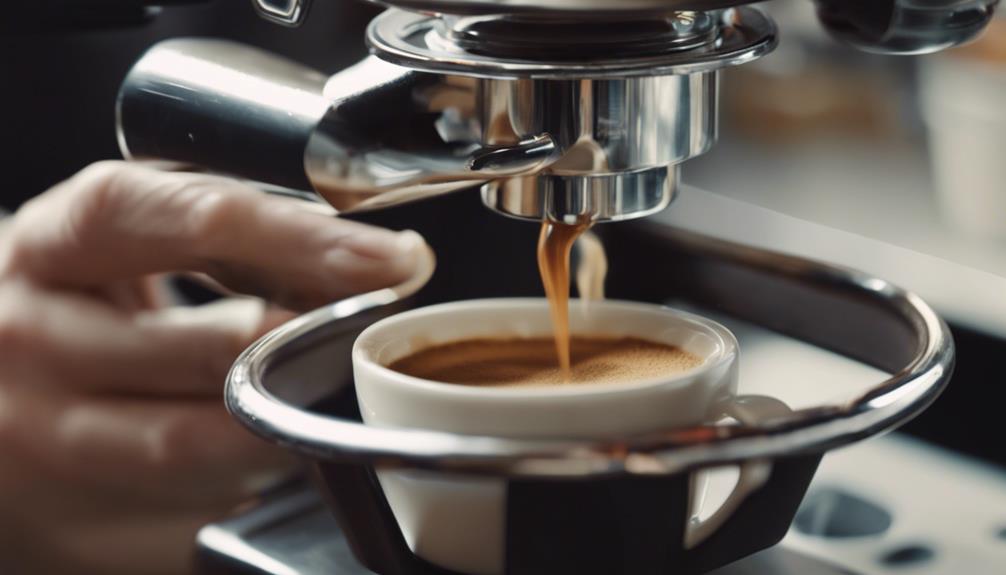
Using a puck screen during the brewing process can greatly enhance the extraction of decaf blonde espresso by ensuring even distribution of water over the coffee puck. This tool plays an essential role in preventing channeling and maintaining a consistent flow through the coffee bed, resulting in a more balanced and flavorful cup of decaf espresso.
Decaf beans, known for their brittleness and fragility, can benefit immensely from the use of a puck screen. By incorporating this device into your brewing routine, you pave the way for a more delicious and satisfying coffee experience. The puck screen acts as a barrier that helps evenly distribute water, allowing for a more uniform extraction of flavors from the coffee grounds. This level of consistency contributes to a smoother taste profile and a more enjoyable drinking experience.
For those seeking to elevate their decaf blonde espresso game, investing in a puck screen is a simple yet effective way to enhance the overall quality of your brew.
Increasing Brew Ratio for Better Flavor

To enhance the flavor extraction of your decaf blonde espresso, consider increasing the brew ratio instead of adjusting the grind size. This method helps balance the sweetness and acidity in your cup without compromising on taste.
Enhanced Flavor Extraction
Consider adjusting the brew ratio to enhance flavor extraction in your decaf blonde espresso without the need to grind finer. By increasing the brew ratio, you can achieve a more balanced and flavorful cup without compromising the quality of your espresso.
Here are some tips to help you enhance flavor extraction:
- Use the Right Amount: Start with 18g of coffee to yield 41g of espresso in around 23 seconds for a well-balanced taste.
- Balance Sweetness and Acidity: Adjusting the brew ratio allows you to find the perfect balance between sweetness and acidity, enhancing the overall flavor profile of your decaf blonde espresso.
- Maintain Consistency: Be mindful of grinder drift and ensure uniformity in extraction to achieve excellent results in every cup.
- Visual Differences: Focus on making proper adjustments to overcome any visual disparities that may arise during the brewing process, resulting in a delicious and satisfying decaf blonde espresso experience.
Adjusting Grind Size
For a more flavorful decaf blonde espresso, adjusting the grind size to increase the brew ratio can enhance the overall taste profile without compromising quality. Decaf coffee's increased solubility requires careful consideration when grinding to prevent over-extraction and bitterness.
By utilizing a finer grind, you risk extracting undesirable flavors, whereas a coarser grind can help maintain the quality of the extraction process. Increasing the brew ratio, like using 18g of coffee in and extracting 41g out in 23 seconds, can create a harmonious blend of sweetness and acidity in your decaf espresso.
Grinding coarser not only helps avoid fines but also ensures proper extraction, contributing to a richer flavor profile. To overcome the brittleness of decaf beans, consider using a puck screen for even water distribution, promoting a consistent extraction.
With the right adjustments and mindset, you can still achieve a delicious decaf espresso, even if visual cues like a pale crema may differ from traditional espresso.
Brewing Time Optimization
Adjusting the brewing time and increasing the brew ratio can greatly enhance the flavor profile of your decaf blonde espresso without the need to grind finer. By following these steps, you can achieve a more balanced and delicious cup of decaf espresso:
- Enhance Brew Ratio: Aim for a brew ratio of 1:2.3, such as using 18g of coffee and extracting 41g of espresso in about 23 seconds.
- Monitor Grinder Drift: Keep an eye on your grinder's consistency as it may affect the extraction. Adjust as necessary to maintain quality.
- Improve Crema: Decaf espresso might've a lighter crema. Stirring it can help improve the taste and overall experience.
- Achieve Sweetness: Proper adjustments in brew ratio can lead to a sweeter and more flavorful decaf espresso. Experiment with different ratios to find your perfect balance.
Optimizing your brewing time and brew ratio is key to enhancing the full potential of your decaf blonde espresso, ensuring a delightful and satisfying coffee experience.
Grind Size Adjustment Tips
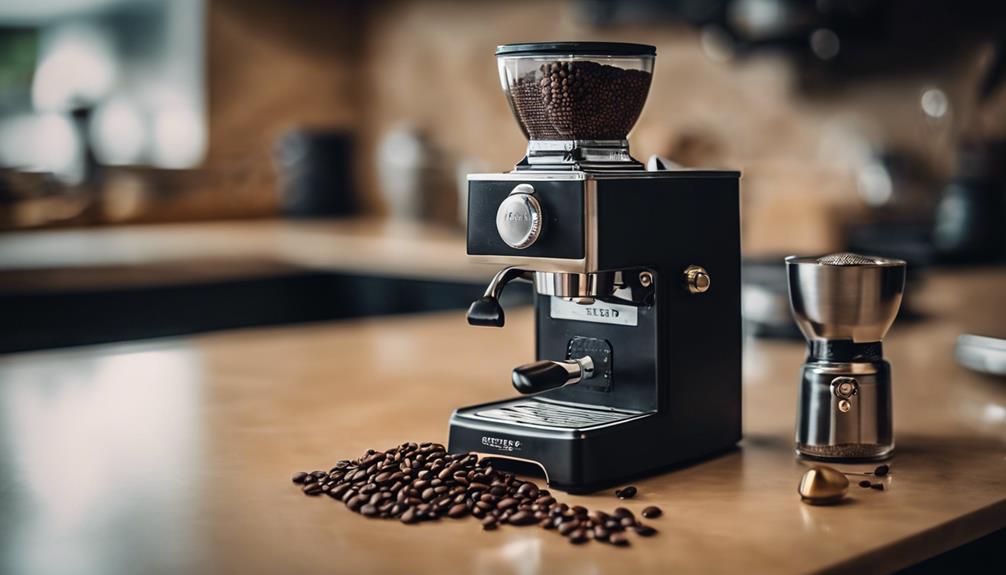
To optimize the extraction of flavor compounds in decaf espresso, make sure your grind size is adjusted appropriately. When grinding coarser for decaf espresso, you can avoid fines, but be mindful of potential flow issues during extraction. Using a puck screen can assist in improving water distribution and extraction, enhancing the overall taste of your decaf espresso. Instead of grinding finer, consider increasing the brew ratio to achieve a better balance between sweetness and acidity in your cup. It's essential to exercise caution with higher dosing when adjusting grind size to prevent under-extraction, which can result in a subpar taste experience. By making proper grind size adjustments, you can enjoy a sweeter and more delicious cup of decaf espresso.
| Grind Size Adjustment Tips |
|---|
| Grinding coarser helps avoid fines but may lead to flow issues. |
| Using a puck screen improves water distribution and extraction. |
| Increasing brew ratio balances sweetness and acidity effectively. |
| Be cautious with higher dosing to prevent under-extraction. |
| Proper grind size adjustments result in a sweeter cup of decaf. |
Achieving a Sweeter Cup of Decaf

To enhance the sweetness of your decaf espresso, focus on adjusting the brew ratio rather than grinding finer. By following this approach, you can achieve a more balanced and flavorful cup of decaf blonde espresso. Here are some tips to help you achieve a sweeter brew:
- Brew Ratio Adjustment: Experiment with different coffee-to-water ratios to find the ideal balance of sweetness and acidity. For example, using 18g of coffee to extract 41g in 23 seconds can help you achieve a delicious cup.
- Grind Coarser: Instead of grinding finer, try adjusting your grind to be coarser to avoid extracting bitter flavors from the coffee beans.
- Use a Puck Screen: Guarantee even water distribution by using a puck screen, which can help improve the overall extraction process and enhance the sweetness of your espresso.
- Extend Brew Time: Consider extending the brew time slightly to allow for a more even extraction, which can lead to a sweeter and more delicious decaf espresso.
Mindset Shift for Decaf Enjoyment

Embrace a new perspective on decaf espresso enjoyment by focusing on the rich taste and quality of the coffee rather than fixating on its caffeine content. When you shift your mindset towards appreciating the flavors and aromas of decaf espresso, you open yourself up to a world of intricate taste profiles and nuanced brewing techniques.
Stirring your decaf espresso can help enhance its flavor, compensating for any visual differences you may notice, such as a paler crema. By understanding and implementing the correct treatment for decaf espresso, you can discover a delicious and satisfying cup that rivals its caffeinated counterpart.
Making subtle adjustments in your brewing methods can lead to a sweeter and more delightful decaf espresso experience. Remember, the key to enjoying decaf espresso to its fullest potential lies in your mindset shift, paving the way for a rewarding coffee experience that focuses on quality and taste above all else.
Satisfying Decaf Coffee Experience
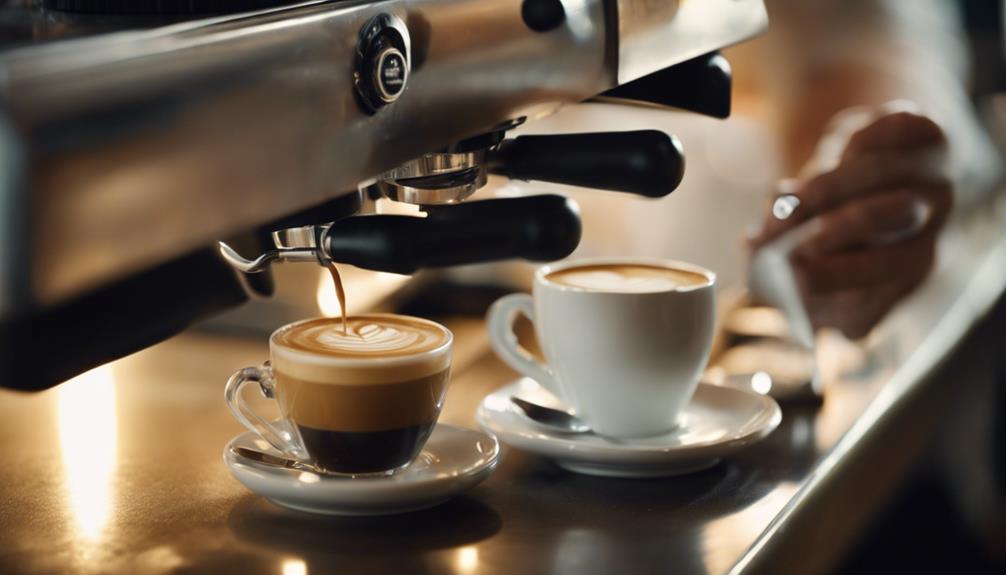
To fully enjoy the satisfying decaf coffee experience, consider the benefits of Decaf Blonde Espresso.
When brewing decaf espresso, pay attention to the increased solubility and adjust brewing techniques accordingly.
Explore flavorful decaf options by focusing on taste rather than appearance, balancing sweetness and acidity for a delightful cup.
Decaf Blonde Benefits
Experience the satisfying allure of Decaf Blonde espresso, promising a delightful decaf coffee journey with its lighter roast profile.
Here are the benefits that come with indulging in this delicious decaf option:
- Full Flavor, No Caffeine: Enjoy the benefits of decaf without sacrificing flavor or complexity in your espresso drinks.
- Caffeine Control: Perfect for those looking to limit caffeine intake while still savoring a quality espresso shot.
- Smooth and Balanced: Provides a smooth and balanced taste with notes of sweetness and acidity, making it ideal for a variety of espresso-based drinks.
- Jitter-Free Enjoyment: Experience the same delicious espresso experience without the caffeine jitters that can sometimes accompany regular coffee.
Decaf Blonde espresso offers a rich and flavorful coffee experience without the caffeine kick, perfect for those seeking a more mellow yet equally satisfying coffee indulgence.
Brewing Decaf Espresso
When brewing Decaf Espresso for a satisfying decaf coffee experience, it's important to take into account the unique characteristics and brewing techniques specific to decaffeinated coffee beans.
Decaf coffee possesses increased solubility due to the decaffeination process, making it prone to over-extraction if treated like regular espresso. To counter this, aim for a lower brew time of around 20 seconds. Given decaf's brittleness, grind coarser to avoid fines, use a puck screen for even water distribution, and consider a slightly higher dose to prevent under-extraction.
Adjust the brew ratio by increasing it rather than grinding finer, seeking a balance between sweetness and acidity while being wary of grinder drift impacting consistency. Employ a method that acknowledges decaf's enhanced solubility and brittleness, utilize a puck screen for improved water flow, and extend the brew ratio for a sweeter cup.
Despite visual differences like a lighter crema, stirring can enhance the taste. Focus on proper treatment to achieve a satisfying decaf espresso experience.
Flavorful Decaf Options
Look for decaf blonde espresso options that prioritize flavor and quality, such as single-origin decaffeinated beans, to enhance your satisfying decaf coffee experience.
When exploring flavorful decaf options, consider these tips:
- Choose Specialty Roasters: Opt for decaf blonde espresso from specialty coffee roasters known for their expertise in decaffeination processes to guarantee a premium quality cup.
- Explore Decaffeination Methods: Experiment with different decaffeination methods like Swiss Water Process or CO2 process to discover the best flavor profile that aligns with your taste preferences.
- Check Tasting Notes: Select decaf blonde espresso with tasting notes that resonate with you, such as fruity, floral, or chocolatey, for a delightful coffee experience.
- Adjust Brewing Parameters: Fine-tune brewing parameters like grind size, water temperature, and extraction time to uncover the full range of flavors in your decaf blonde espresso. Experimentation can help you optimize the taste to suit your palate perfectly.
Frequently Asked Questions
Can You Get Blonde Espresso Decaf?
Yes, you can indeed get blonde espresso decaf.
While it may not be as common as regular blonde espresso, some coffee shops and roasters offer this option.
If you're looking for decaf blonde espresso, check with local coffee establishments or search online for roasters that sell decaf blonde espresso beans.
It's always a good idea to inquire about availability to make sure you can enjoy this milder, lighter roast without the caffeine.
How to Pull a Decaf Espresso Shot?
To pull a decaf espresso shot effectively, consider adjusting your brewing parameters for the unique qualities of decaf beans. Use a puck screen for even water distribution and a slightly higher dose to prevent grinding too fine.
Instead of a finer grind, adjust the brew ratio for a balanced shot. Expect a paler crema but focus on taste.
With proper grind size, dose, and ratio adjustments, you'll enjoy a sweeter decaf espresso experience.
How to Make Decaf Espresso Taste Good?
To make decaf espresso taste good, adjust the brew ratio by increasing it for a balanced sweetness and acidity. Grind coarser to avoid over-extraction and use a puck screen for even water distribution.
Despite a different appearance, stirring can enhance the taste. Focus on correct treatment to achieve a delicious decaf espresso.
Properly adjust grind size, dosing, and extraction time for a sweeter and more flavorful cup.
Can You Get Decaf Blonde Roast at Starbucks?
If you're on the hunt for decaf blonde espresso at Starbucks, you're out of luck. Starbucks doesn't offer a decaf version of their Blonde Roast espresso.
You'll have to settle for a medium or dark roast if you're craving decaf. But fear not! Specialty coffee shops or online retailers may have what you seek.
Look around for specialty coffee roasters that offer decaf espresso beans in varying roast levels, including light or blonde roasts.
Where Can I Find Decaf Blonde Espresso Besides Dunkin?
If you’re looking for dunkin blonde espresso availability outside of Dunkin’, you can try checking out other popular coffee chains, such as Starbucks or Peet’s Coffee. You may also want to explore specialty coffee shops or online retailers that offer decaf blonde espresso options.
Can Decaf Blonde Espresso Help Reduce Bitterness in Espresso Shots?
Yes, decaf blonde espresso can help reduce the causes of espresso bitterness in shots. Its lighter roast and lower acidity can result in a smoother, less bitter flavor. Switching to decaf blonde espresso may be a good option for those looking to cut down on the bitterness in their espresso.
Conclusion
To sum up, getting your hands on decaf blonde espresso can be a rewarding experience with the right knowledge and techniques. By understanding the characteristics of decaf coffee, adjusting brewing methods, and making small tweaks to your process, you can achieve a satisfying cup of decaf.
So why not give it a try and see for yourself how enjoyable and delicious decaf coffee can be?


